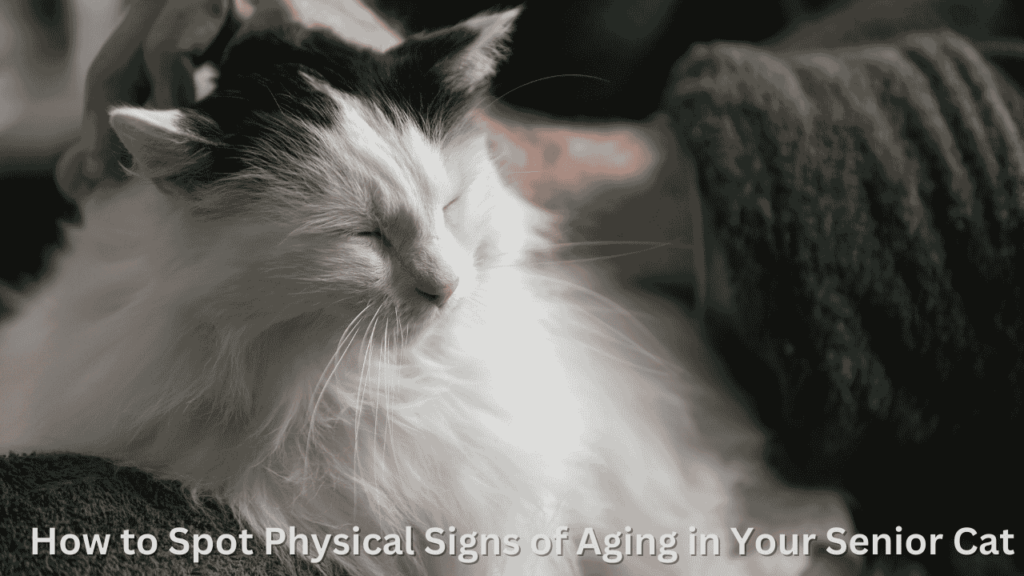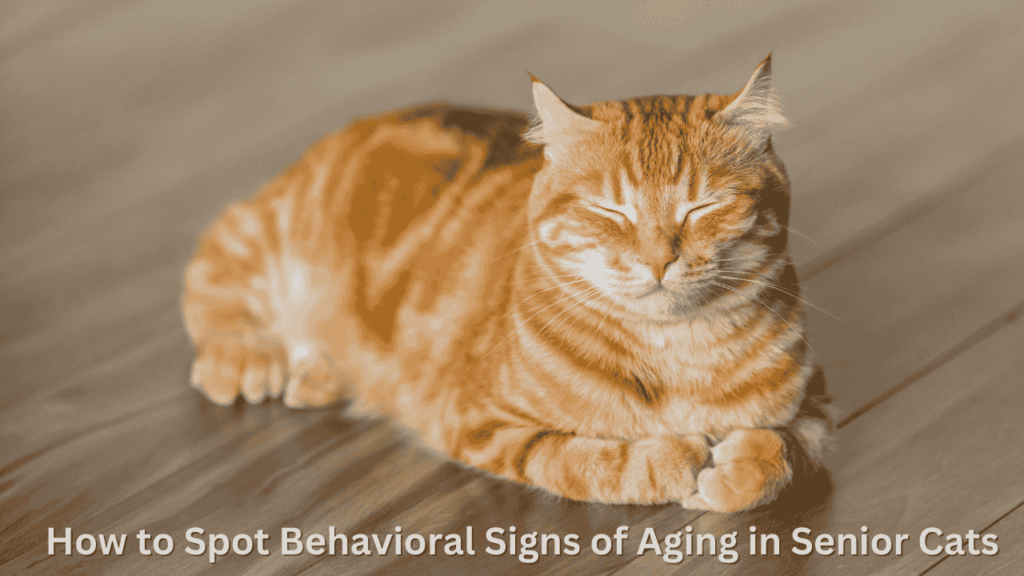If you’re a cat parent, you already know how quickly time flies. One moment, your kitten is bounding around, pouncing on anything that moves, and the next, they’re curling up in the sun for an afternoon nap. But how can you tell when your furry friend is truly entering their senior years?
As cats age, they go through subtle but important changes that can affect their health, behavior, and overall quality of life. How to spot signs of aging in older cats is something every dedicated pet owner should know. After all, catching these changes early means you can provide the right care and keep your cat comfortable and happy for years to come.
In this article, we’ll dive into the physical and behavioral shifts that happen as cats grow older. We’ll also explore some common age-related health conditions and what you can do to help your feline friend through their golden years. Let’s jump right in and learn how to spot the signs of aging in your older cat!

How to Spot Physical Signs of Aging in Your Senior Cat
As cats grow older, they often start to show physical signs of aging. These changes may be subtle at first, but paying close attention can help you stay on top of your cat’s health. Let’s break down some of the most noticeable physical changes in senior cats:
1. Graying Fur and Thinning Coat
Just like humans, cats show signs of aging in their fur. If your cat was once a vibrant shade of black, gray, or orange, you may begin to notice some changes.
- Graying Fur: Many older cats develop gray or white hairs around their face, paws, or chest. This is a natural sign of aging, though it can also be influenced by genetics.
- Thinning Coat: As cats age, their coats may become thinner, especially in long-haired breeds. They may shed more than usual, or conversely, older cats can sometimes develop matted fur due to their inability to groom themselves properly.
What you can do: Regular grooming is essential. If your senior cat’s coat is thinning or becoming matted, frequent brushing can help keep it clean and healthy. Make sure to keep an eye out for tangles, especially if your cat is unable to groom as effectively.
2. Weight Changes: Weight Loss or Gain?
Weight loss or weight gain is another common sign of aging. Older cats may start to lose muscle mass, or they may gain weight due to decreased activity levels or changes in their metabolism.
- Weight Loss: If your cat is losing weight, it could be due to a variety of factors, including dental issues, arthritis, or digestive problems. Weight loss can sometimes indicate an underlying health condition such as hyperthyroidism or kidney disease.
- Weight Gain: On the flip side, some older cats become less active and may gain weight. Weight gain can lead to obesity, which can exacerbate other health problems like arthritis, diabetes, or heart disease.
What you can do: Keep an eye on your cat’s weight by regularly weighing them and monitoring their diet. If you notice significant weight loss or gain, a trip to the vet is essential to rule out any health issues.
3. Reduced Mobility and Stiffness
As cats age, their joints can become stiff, and they may have difficulty jumping, climbing, or even walking around the house as they once did. If your cat is showing signs of reduced mobility, such as favoring a leg, having trouble climbing stairs, or struggling to get in and out of their favorite spots, arthritis or other joint conditions may be at play.
- Arthritis: One of the most common issues in senior cats is arthritis. This condition causes joint inflammation and pain, which makes movement more difficult and uncomfortable.
What you can do: If your cat seems stiff or reluctant to move, it’s important to speak with your vet. There are many ways to help manage arthritis in cats, including special joint supplements, pain medications, and physical therapy.

How to Spot Behavioral Signs of Aging in Senior Cats
While physical signs of aging are often easier to spot, there are also important behavioral changes that can indicate your cat is entering their senior years. Some of these changes are directly related to physical discomfort, while others may be more psychological. Here are some common behavioral signs to look for:
1. Decreased Activity and Playfulness
Older cats may slow down, and this is perfectly normal. However, a noticeable decrease in activity levels or interest in playing could be a sign of aging. You may notice that your cat no longer shows the same curiosity about new toys, or they may stop chasing after laser pointers or feather wands.
What you can do: While it’s natural for senior cats to slow down, it’s still important to engage them in low-impact activities that stimulate their minds and bodies. Puzzle toys, gentle interactive play, and offering a warm lap for them to curl up on can keep them mentally active.
2. Changes in Sleep Patterns
Cats sleep a lot—up to 16 hours a day in some cases—but older cats tend to sleep even more. If you notice your senior cat spending extra time sleeping, this may simply be a natural result of aging.
However, in some cases, changes in sleep patterns could indicate an underlying issue, such as pain, anxiety, or cognitive dysfunction.
What you can do: Keep an eye on any drastic changes in your cat’s sleep schedule. If they’re sleeping more than usual and showing signs of disorientation or confusion, they could be experiencing feline cognitive dysfunction syndrome (CDS), which is similar to dementia in humans. Your vet can help manage these changes.
3. Altered Grooming Habits
Older cats may not groom themselves as efficiently as they did in their younger years. You may notice that your cat is not as meticulous with their grooming or has areas of their fur that appear greasy, matted, or unkempt.
This change in behavior could be due to physical issues such as arthritis, dental pain, or simply a lack of energy.
What you can do: Be prepared to help your cat maintain their coat by brushing them more frequently. Regular grooming not only helps with cleanliness but also provides a bonding opportunity. If your cat suddenly starts over-grooming or licking excessively, it could be a sign of anxiety or health issues, and a visit to the vet is advisable.
Health Concerns to Be Aware Of in Older Cats
Aging cats are more susceptible to certain health conditions, and spotting them early can make a world of difference in managing your cat’s well-being. Here are some common health problems to watch for:
1. Kidney Disease
Kidney disease is one of the most common conditions in older cats. It can lead to symptoms such as increased thirst, frequent urination, and weight loss.
What you can do: Regular vet checkups and blood tests can help detect kidney disease early. Ensuring your cat has access to fresh water at all times is crucial for kidney health.
2. Dental Issues
Dental disease is common in older cats. Cats may develop gum disease, tooth decay, or bad breath. If your cat is showing signs of oral pain, such as drooling, difficulty eating, or pawing at their face, it’s time to consult the vet.
What you can do: Regular dental checkups and cleanings are essential for senior cats. You can also help by providing dental treats or special food that supports oral health.
3. Hyperthyroidism and Diabetes
Both hyperthyroidism and diabetes are more common in senior cats. Symptoms of hyperthyroidism include weight loss, increased appetite, and restlessness. Diabetes can cause weight loss, increased thirst, and frequent urination.
What you can do: Keep a close eye on changes in your cat’s appetite, water consumption, and litter box habits. If you notice anything unusual, take them to the vet for testing.
Frequently Asked Questions (FAQs)
1. How old is a senior cat?
Most cats are considered “senior” at around 7 years old. However, this can vary by breed, and larger breeds may age faster.
2. Can a senior cat still enjoy playtime?
Yes! Even older cats can enjoy playtime, though their energy levels may be lower. Opt for gentler, slower-paced games.
3. When should I take my senior cat to the vet?
It’s important to take your senior cat for regular vet checkups, typically every 6 to 12 months. If you notice any signs of discomfort, unusual behavior, or physical changes, don’t hesitate to make an appointment.
Conclusion: Caring for Your Senior Cat
As your cat enters their senior years, it’s important to stay attuned to the signs of aging. By spotting changes early, you can ensure that your senior feline remains as comfortable, happy, and healthy as possible.
Whether it’s adjusting their diet, increasing grooming sessions, or seeking medical treatment for age-related conditions, every step you take is an act of love and care. Your older cat may be slowing down, but with your help, they’ll still lead a fulfilling, content life.
So, what signs of aging have you noticed in your cat? Share your experiences with us in the comments!

